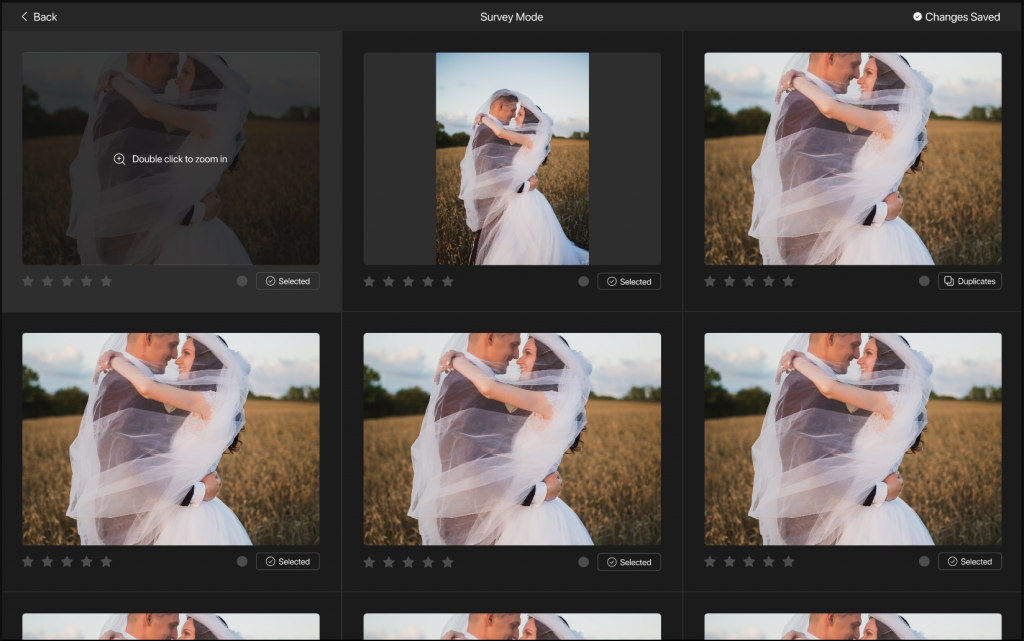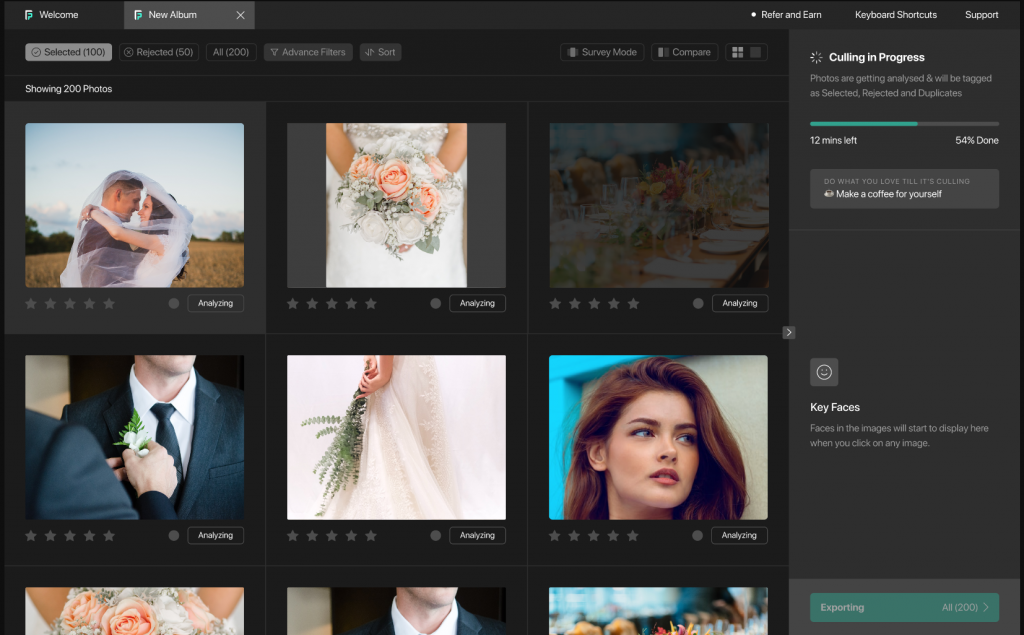The advent of artificial intelligence in the realm of photography has ushered in a plethora of tools promising to simplify the lives of photographers. Yet, the question lingers: is AI photography software truly deserving of the buzz it generates? What are the pros and cons of AI culling?
Since the birth of digital photography, individuals traditionally relied on personal judgments and experiences to manually curate their photo libraries. This approach sufficed at the time, considering the photography hardware and software technologies available then.
However, with today’s rapid advancements and the exponential growth of the photography industry, the limitations of manual photo culling have become increasingly apparent.
Conversely, AI-driven photo culling stands in stark contrast. Regarded as a game-changer in the photography industry, automated programs like FilterPixel have revolutionized the culling process. It can significantly reduce the time spent on culling images by at least 80%, employing AI algorithms to make automated decisions based on predefined criteria. The result is a swift and accurate production of consistent, high-quality images.
Nevertheless, skepticism persists among some photography enthusiasts and professionals on integrating AI into their post-production processes. In this article, we’ll explore the pros and cons of both traditional and AI-powered photo culling, helping you decide which approach best suits your needs.
Pros and Cons of Traditional Photo Culling

While manual photo culling is often dreaded by professional photographers and enthusiasts, it also has some advantages. Let’s break down the pros and cons of traditional photo culling.
Advantages of Manual Culling
Hands-On Control
One of the most significant advantages of traditional photo culling is that you can personally select which images make it to editing. As you manually review each photo, you have the power to decide what to keep and which ones to discard. This process allows for a personalized touch, ensuring that your unique photography style is not overlooked.
Artistic Judgment
Traditional culling enables you to exercise your artistic judgment that may go against the basic rules of photography. You can select images based on specific aesthetic factors that only you, as the artist, can justify. This can be crucial, especially for photography enthusiasts who see their photo collection as a form of artistic expression.
Selective Memory Preservation
With traditional culling, you can be selective about the memories you want to preserve. This approach allows you to curate a collection that tells a story, capturing the essence of moments that hold emotional significance to you. For casual and even professional photographers, this helps in ensuring that your treasured images won’t be discarded, even if they are not the best technicality-wise.
Disadvantages of Manual Culling
Time-Consuming
Perhaps the most significant drawback of traditional culling is the time it consumes. Going through hundreds or thousands of photos manually is a labor-intensive process, and in our fast-paced lives, time is a precious commodity. In fact, studies show that professional photographers spend 18% of their time sorting photos. Wedding photographers, in particular, spend at least 2 hours of photo culling per event. The time you could have spent accommodating more photo sessions or editing images is practically consumed by photo culling alone.
Overwhelming Volume
As your digital photo libraries grow, the sheer volume of images can be overwhelming. It’s easy to get lost in the sheer volume, and the thought of manually inspecting each one is discouraging and frustrating. Traditional culling tends to become a daunting task, leading many to procrastinate and eventually neglect the process altogether.
Subjectivity
While the subjective nature of traditional culling can be a pro, it can also be a con. Personal biases and emotions highly influence your choices. This could be brought about by decision fatigue, tiredness, or even over-excitement. In result, it potentially causes you to overlook objectively good photos or keep ones that lack broader significance. This subjectivity not only affects the photo set you’re working on, but your entire body of work. Maintaining a consistent style and quality across your portfolio then becomes an even more difficult task.
Pros and Cons of AI Culling
AI photo culling generally leverages the power of technology to transform your photo culling experience into a quick and seamless task. Understandably, some photographers hesitate to dive into AI-driven culling software for different reasons.
Pros of AI-Powered Photo Culling

Time-Efficiency
AI-powered photo culling tools are designed to save you time. Using algorithms and machine learning, these tools can quickly analyze and categorize photos. They are designed to significantly reduce the time and effort required for manual review. In a study we recently conducted, we found that AI-powered culling tools have demonstrated an impressive 80% reduction in the time spent on initial photo selection. This allows photographers to allocate more time to refining their craft, engaging with clients, and growing their business.
Smart Organization
AI excels at pattern recognition and can automatically organize your photos based on various criteria such as date, location, or even facial recognition. This intelligent organization feature simplifies the process of finding specific images within vast collections. It also makes maintaining a structured library more feasible and sustainable. Having consistently organized collections is the key to having streamlined post-production processes.
Objective Analysis
Unlike humans, AI does not implement its own biases. It assesses photos based on your predefined criteria, ensuring a more objective selection. This can be particularly helpful when you want to create a collection that reflects your clients’ specific requirements. Utilizing AI in such cases will enable you to curate consistent photo sets that follow through with set standards.
Boosts Creativity
Contrary to what most people think, AI-powered photo culling actually enables for further creativity. Photographers often get preoccupied with the thought of their growing post-production pile which becomes a huge distraction and limiting factor during shoots. With a structured importing and sorting process in place, you will have more time and energy to focus on the creative aspects of photography in order to deliver high quality work.
Streamlines Photography Workflows
When your photos are organized and cataloged, you can seamlessly progress from one post-production phase to the next. It will help you save a lot of time and resources, while reducing the risk of errors and inconsistencies. Because photo culling sets the stage for editing, an efficient selection and organization process leads to faster and more consistent edits.
Cons of AI-Powered Photo Culling
Lack of Emotional Understanding
AI lacks emotional intelligence. While it can identify faces and objects, it may struggle to grasp the emotional nuances that make certain moments special to you. This limitation might result in the unintentional exclusion of photos that hold sentimental value.
Potential for Errors
Like any technology, AI is not infallible. It may misinterpret images, leading to the misclassification or exclusion of important photos. Relying solely on AI without human oversight could result in errors that might go unnoticed.
Standardized Criteria
AI algorithms operate based on standardized criteria, which might not align with your personal preferences. The tools might prioritize technical aspects like sharpness and exposure over the emotional resonance of a portrait, for example.
Striking a Balance Between Traditional and AI Culling

As with many technological advancements, finding the right balance often yields the most ideal results. Acknowledging the pros and cons of AI Culling and traditional selection can help you determine a solid ground. The goal is to combine the strengths of both traditional and AI-powered culling so you can get you the best of both worlds.
Efficiency with Personal Touch
By leveraging AI for the initial sorting and categorization, you can save time and reduce the overwhelming volume of photos. Once the AI has done its work, you can then apply your personal touch during the final culling stages. This ensures that each chosen photo resonates with you– reflecting your unique style and preferences.
AI-Assisted Organization
AI can assist in organizing your photos, making it easier for you to navigate through your collection. This not only allows you to locate specific photos, but also to streamline your workflow through editing. With a structured photo library, you can implement batch editing, which further enhances the consistency and quality of your final results.
Objective Analysis with Human Insight
Combining AI’s objectivity with your human insight allows for a more balanced photo selection. You can use AI suggestions as a starting point and refine the choices based on your emotional connection and artistic judgment.
Choosing What Works for You
In the eternal debate of traditional vs. AI-powered photo culling, there is no one-size-fits-all solution. The right approach depends on your priorities, the size of your photo library, and the value you place on personal involvement in the culling process. Understand how each of the pros and cons of AI and traditional culling impact your workflow.
If you cherish the hands-on control, artistic judgment, and selective memory preservation that traditional culling offers, invest the time and effort into curating your photo collection manually. However, if time efficiency, smart organization, and objective analysis are your priorities, AI-powered tools might be the key to managing your digital memories effectively.
Ultimately, the ideal solution may lie in a hybrid approach that combines the strengths of both methods. By striking a balance between the efficiency of AI and the personal touch of traditional culling, you can create a curated photo collection that reflects your unique perspective while ensuring consistency and quality.
Ready to integrate the power of AI in your post-production process?

FilterPixel is a game-changing solution that is set to transform the way you organize and post-process your images by harnessing the power of AI. From the fundamental stages of importing and sorting photos, to the more technical areas of culling and editing, FilterPixel provides you with a smarter and easier way to go through all of these phases in producing top-quality images. Its remarkable ability to shorten the culling process by 80% and its highly customizable controls empower photographers of all levels of expertise to streamline their processes while maintaining total creative reign over their images.
Learn more about what we offer: https://filterpixel.com/